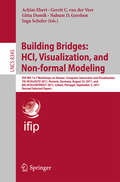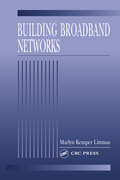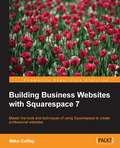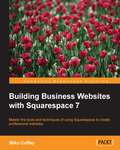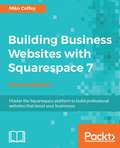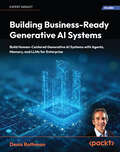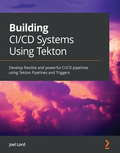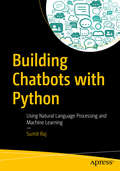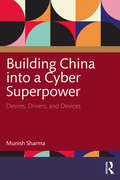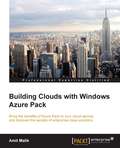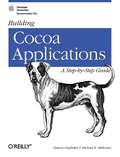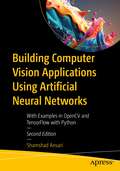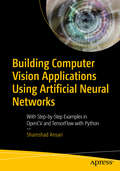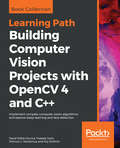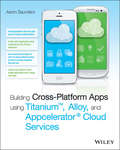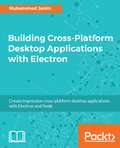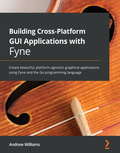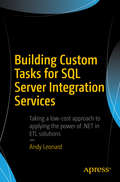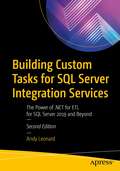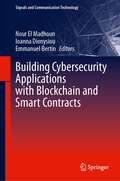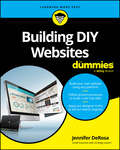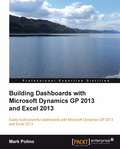- Table View
- List View
Building Bridges: IFIP WG 13.7 Workshops on Human–Computer Interaction and Visualization: 7th HCIV@ECCE 2011, Rostock, Germany, August 23, 2011, and 8th HCIV@INTERACT 2011, Lisbon, Portugal, September 5, 2011, Revised Selected Papers (Lecture Notes in Computer Science #8345)
by Achim Ebert Gerrit C. van der Veer Gitta Domik Nahum D. Gershon Inga SchelerThis volume constitutes the refereed post-workshop proceedings of two IFIP WG 13. 7 workshops on Human-Computer Interaction and Visualization: the 7th HCIV Workshop on Non-formal Modelling for Interaction Design, held at the 29th European Conference on Cognitive Ergonomics, ECCE 2011, in Rostock, Germany, in August 2011 and the 8th HCIV Workshop on HCI and Visualization, held at the 13th IFIP TC 13 Conference on Human-Computer Interaction, INTERACT 2011, in Lisbon, Portugal, in September 2011. The 15 revised papers presented were carefully reviewed and selected for inclusion in this volume. They cover a wide range of topics in the fields of non-formal modeling, visualization and HCI and provide visions from researchers working at or across the borders between these domains that may help develop a holistic cross-discipline.
Building Broadband Networks
by Marlyn Kemper LittmanOptical networks, undersea networks, GSM, UMTS The recent explosion in broadband communications technologies has opened a new world of fast, flexible services and applications. To successfully implement these services, however, requires a solid understanding of the concepts and capabilities of broadband technologies and networks.Building Br
Building Browser Extensions: Create Modern Extensions for Chrome, Safari, Firefox, and Edge
by Matt FrisbieAlmost all web developers today have plenty of experience with building regular web page apps, but a lot of that knowledge doesn't transfer over when it comes to creating browser extensions. This book provides a complete reference for how to build modern browser extensions. Creating and deploying a browser extension is more like building a mobile app than a website. When you start building an extension you'll often find there are a large number of new concepts and idiosyncrasies to wrangle with. This book reveals how to successfully navigate around these obstacles and how to take advantage of the limited resources available. You'll see how a browser extensions work, their component pieces, and how to build and deploy them. Additionally, you'll review all the tricky bits of extension development that most developers have to learn through trial and error. The current transition from manifest v2 to v3 is of special interest, and an entire chapter will be dedicated to this subject. By the end of this book, you will have a rich understanding of what browser extensions are, how they work, all the pitfalls to avoid, and the most efficient ways of building them.What You’ll LearnExamine the different components of browser extensions and how they behaveReview common pitfalls developers encounter when building browser extensions and how to avoid themDevelop, deploy, and manage a published browser extensionBuild a browser extension using modern JavaScript frameworksWho This Book Is ForDevelopers tasked with building a supplementary browser extension to go alongside their existing product. This book also targets people that have at least a basic understanding of the fundamentals of web development and wish to quickly understand how they can roll out a browser extension.
Building Business Websites with Squarespace 7
by Miko CoffeyThis book is ideal for anyone who wants to learn how to use the latest version of Squarespace to create a website from scratch and take it through to go-live. You don't need any prior experience with Squarespace, HTML or CSS, or building websites in general as everything is done using Squarespace's simple, browser-based interface.
Building Business Websites with Squarespace 7
by Miko Coffey<P><P>Master the tools and techniques of using Squarespace to create professional websites <P><P>About This Book <P><P>Use all of the Squarespace functions to design, build, launch, and analyze your website <P><P>Employ this step-by-step, approach to discover the best process for building websites with Squarespace, including tips and advice specifically for businesses <P><P>Discover how to tailor Squarespace templates and functions to your business needs, whether it's an information site, online portfolio, or e-commerce store <P><P>Who This Book Is For <P><P>This book is ideal for anyone who wants to learn how to use the latest version of Squarespace to create a website from scratch and take it through to go-live. You don't need any prior experience with Squarespace, HTML or CSS, or building websites in general as everything is done using Squarespace's simple, browser-based interface. <P><P>What You Will Learn <P><P>Create your website framework, fill it with content, and arrange your pages using Squarespace's drag and drop layout tools <P><P>Customize your site's look and feel to match your brand, and create stunning visual impact, even on mobile and tablet devices <P><P>Configure the core functions your business needs such as sharing to social media, showcasing your work, or selling goods and services online <P><P>Discover time-saving tricks and how to avoid common pitfalls from an experienced professional with years of Squarespace experience <P><P>Gain valuable insights about search engine optimization and other e-marketing advice beyond just how to build a website <P><P>Understand how to monitor, measure, and manage your website post-launch <P><P>Develop an essential Website Toolkit that will act as reference material for your entire project, ensuring you stay on target to meet your objectives <P><P>In Detail <P><P>This practical guide walks you through the various steps involved in building a website for your business with Squarespace. You will learn how to use all of the tools provided by Squarespace to control the layout, appearance, structure, and functions of your website, starting from the inception stage, all the way to monitoring your site after it has been launched. <P><P>This is much more than just a how-to book for the Squarespace system: it's filled with helpful advice that will help you improve your website's visibility in search engines and tailor your site for your customers. Moreover, it provides dozens of other business-oriented tips to help your website stand out from the crowd. If you have used Squarespace 5 or other website builders/CMSes, this book will help you understand the key differences and teach you how to do things based on the new features of Squarespace 7.
Building Business Websites with Squarespace 7 - Second Edition
by Miko CoffeyDiscover the best way to build, design and launch professional websites with Squarespace quickly, without needing to learn any code About This Book • Discover time-saving tricks and best practices, and avoid common pitfalls while creating a website • Create visually stunning Responsive Design templates for your website with Squarespace 7 • Understand how to monitor, measure, and manage your website after launching it Who This Book Is For This book is ideal for anyone who wants to learn how to use the latest version of Squarespace to create a website from scratch and take it through to go-live. You don't need any prior experience with Squarespace, HTML, or CSS, or building websites in general as everything is done using Squarespace's simple, browser-based interface. What You Will Learn • Develop an essential Website Toolkit that will act as reference and materials for your entire project, ensuring you stay on-target to meet your objectives • Set up your Squarespace account, learn how the interface works, and select the correct template for your website's purpose and goals • Create your website framework, fill it with content, and arrange your pages using Squarespace's easy drag-and-drop tools • Customize your site's look and feel to match your brand, and create a stunning visual impact for your website on all types of devices, including mobiles and tablets • Configure the core functions your business needs, whether connecting to social media, promoting events, showcasing your work, or selling goods and services online • Learn time-saving tricks and how to avoid common pitfalls from an experienced professional with years of Squarespace experience • Gain valuable insights about search engine optimization, communicating effectively online, and other e-marketing advice • How to monitor, measure, and manage your website post-launch In Detail Squarespace is a web-based tool that allows non-technical people to create and manage professional-looking websites quickly, without needing to write any code. It empowers business owners to take total control of their own websites, without needing to pay someone to design or maintain it. This book covers much more than just how to use Squarespace. It covers all aspects of creating a successful business website, from developing your brand identity, to writing and structuring content to match your target audience's needs, and dozens of other other valuable tips that will help your website shine. Most importantly, you'll learn the correct steps to follow in order to ensure your project is smooth and stress-free. The book starts by helping you plan your website project and gather all the raw materials you'll need. Next, you'll set up your account and become familiar with the terminology and tools that you'll be using. Once you've learned the basics of how the Squarespace interface, templates, and different page types operate, you will create the framework of your website, ready for you to insert content and functionality. Then, once all the core elements are in place, you'll apply the aesthetic fine-tuning needed to bring your website in line with your brand. After the aesthetics have been honed and all functions tested, you will launch your website and drive traffic to it, monitor it, and improve it. Style and approach This easy-to-follow guide will teach you to build websites the easiest way in the latest version of Squarespace.
Building Business-Ready Generative AI Systems: Build Human-Centered Generative AI Systems with Agents, Memory, and LLMs for Enterprise
by Denis RothmanSupercharge your business with context-aware AI controllers, adaptive agents, multimodal reasoning functionality, neuroscientific memory systems, and flexible handler mechanisms that integrate the emerging generative AI models. Get with your book: PDF copy, AI Assistant, and Next-Gen Reader free.Key FeaturesBuild an adaptive, context-aware AI controller with advanced memory strategiesEnhance GenAISys with multi-domain, multimodal reasoning capabilities and Chain of Thought (CoT)Seamlessly integrate cutting-edge OpenAI and DeepSeek models as you see fitBook DescriptionIn today's rapidly evolving AI landscape, standalone LLMs no longer deliver sufficient business value on their own. This guide moves beyond basic chatbots, showing you how to build advanced, agentic ChatGPT-grade systems capable of sophisticated semantic and sentiment analysis, powered by context-aware AI controllers. You'll design AI controller architectures with multi-user memory retention to dynamically adapt your system to diverse user and system inputs. You'll architect a Retrieval-Augmented Generation (RAG) system with Pinecone, designed to combine instruction-driven scenarios. Enhance your system’s intelligence with powerful multimodal capabilities—including image generation, voice interactions, and machine-driven reasoning—leveraging Chain-of-Thought orchestration to address complex, cross-domain automation challenges. Seamlessly integrate generative models like OpenAI’s suite and DeepSeek-R1 without disrupting your existing GenAISys ecosystem. Your GenAISys will apply neuroscience-inspired insights to marketing strategies, predict human mobility, integrate smoothly into human workflows, visualize complex scenarios, and connect to live external data, all wrapped in a polished, investor-ready interface. By the end, you'll have built a GenAISys capable of deploying intelligent agents in your business environment.What you will learnImplement an AI controller with a conversation AI agent and orchestrator at its coreBuild contextual awareness with short-term, long-term, and cross-session memoryDesign cross-domain automation with multimodal reasoning, image generation, and voice featuresExpand a CoT agent by integrating consumer-memory understandingIntegrate cutting-edge models of your choice without disrupting your existing GenAISysConnect to real-time external data while blocking security breachesWho this book is forThis book is for AI and Machine Learning Engineers seeking to enhance their understanding of Generative AI and its enterprise applications. It will particularly benefit those interested in building AI agents, creating advanced orchestration systems, and leveraging AI for automation in marketing, production, and logistics. Software architects and enterprise developers looking to build scalable AI-driven systems will also find immense value in this guide. No prior superintelligence experience is necessary, but familiarity with AI concepts is recommended.
Building CI/CD Systems Using Tekton: Develop flexible and powerful CI/CD pipelines using Tekton Pipelines and Triggers
by Joel LordAutomate the delivery of applications using Tekton Pipelines and Triggers to deploy new releases quickly and more efficientlyKey FeaturesLearn how to create powerful pipelines using CI/CD toolsUnderstand how to run, deploy and test applications directly in a cloud-native environmentExplore the new Tekton Pipelines 2021 featuresBook DescriptionTekton is a powerful yet flexible Kubernetes-native open source framework for creating continuous integration and continuous delivery (CI/CD) systems. It enables you to build, test, and deploy across multiple cloud providers or on-premise systems.Building CI/CD Systems Using Tekton covers everything you need to know to start building your pipeline and automating application delivery in a cloud-native environment. Using a hands-on approach, you will learn about the basic building blocks, such as tasks, pipelines, and workspaces, which you can use to compose your CI/CD pipelines. As you progress, you will understand how to use these Tekton objects in conjunction with Tekton Triggers to automate the delivery of your application in a Kubernetes cluster.By the end of this book, you will have learned how to compose Tekton Pipelines and use them with Tekton Triggers to build powerful CI/CD systems.What you will learnUnderstand the basic principles behind CI/CDExplore what tasks are and how they can be made reusable and flexibleFocus on how to use Tekton objects to compose a robust pipelineShare data across a pipeline using volumes and workspacesDiscover more advanced topics such as WhenExpressions and Secrets to build complex pipelinesUnderstand what Tekton Triggers are and how they can be used to automate CI/CD pipelinesBuild a full CI/CD pipeline that automatically deploys an application to a Kubernetes cluster when an update is done to a code repositoryWho this book is forThis continuous integration and continuous delivery book is for anyone who wants to learn about one of the most powerful Kubernetes-native CI/CD systems - Tekton. Software developers who want to leverage the Custom Resource Definitions (CRDs) in Kubernetes and use Tekton to run pipeline tasks in order to build and own application delivery pipelines will also find this book particularly helpful. Beginner-level knowledge of software development concepts and Kubernetes is required to get the most out of this book.
Building Capacity to Reduce Bullying: Workshop Summary
by Patti SimonBullying - long tolerated as just a part of growing up - finally has been recognized as a substantial and preventable health problem. Bullying is associated with anxiety, depression, poor school performance, and future delinquent behavior among its targets, and reports regularly surface of youth who have committed suicide at least in part because of intolerable bullying. Bullying also can have harmful effects on children who bully, on bystanders, on school climates, and on society at large. Bullying can occur at all ages, from before elementary school to after high school. It can take the form of physical violence, verbal attacks, social isolation, spreading rumors, or cyberbullying. Increased concern about bullying has led 49 states and the District of Columbia to enact anti-bullying legislation since 1999. In addition, research on the causes, consequences, and prevention of bullying has expanded greatly in recent decades. However, major gaps still exist in the understanding of bullying and of interventions that can prevent or mitigate the effects of bullying. Building Capacity to Reduce Bullying is the summary of a workshop convened by the Board on Children, Youth, and Families of the Institute of Medicine and National Research Council in April 2014 to identify the conceptual models and interventions that have proven effective in decreasing bullying, examine models that could increase protective factors and mitigate the negative effects of bullying, and explore the appropriate roles of different groups in preventing bullying. This report reviews research on bullying prevention and intervention efforts as well as efforts in related areas of research and practice, implemented in a range of contexts and settings, including schools, peers, families, communities, laws and public policies, and technology. Building Capacity to Reduce Bullying considers how involvement or lack of involvement by these sectors influences opportunities for bullying, and appropriate roles for these sectors in preventing bullying. This report highlights current research on bullying prevention, considers what works and what does not work, and derives lessons learned.
Building Chatbots with Python: Using Natural Language Processing And Machine Learning
by Sumit RajBuild your own chatbot using Python and open source tools. This book begins with an introduction to chatbots where you will gain vital information on their architecture. You will then dive straight into natural language processing with the natural language toolkit (NLTK) for building a custom language processing platform for your chatbot. With this foundation, you will take a look at different natural language processing techniques so that you can choose the right one for you. The next stage is to learn to build a chatbot using the API.ai platform and define its intents and entities. During this example, you will learn to enable communication with your bot and also take a look at key points of its integration and deployment.The final chapter of Building Chatbots with Python teaches you how to build, train, and deploy your very own chatbot. Using open source libraries and machine learning techniques you will learn to predict conditions for your bot and develop a conversational agent as a web application. Finally you will deploy your chatbot on your own server with AWS. What You Will LearnGain the basics of natural language processing using Python Collect data and train your data for the chatbotBuild your chatbot from scratch as a web appIntegrate your chatbots with Facebook, Slack, and TelegramDeploy chatbots on your own serverWho This Book Is ForIntermediate Python developers who have no idea about chatbots. Developers with basic Python programming knowledge can also take advantage of the book.
Building China into a Cyber Superpower: Desires, Drivers, and Devices
by Munish SharmaThis book provides a comprehensive look into China’s emerging cyberspace strategy. It highlights the prime drivers of China’s desire to be a cyber superpower and discusses the ways in which China is turning resources into cyber power.The book analyses China’s domestic cyber policy initiatives, strategy documents, censorship measures, and the rationale behind its strong advocacy for sovereignty in cyberspace. It examines China’s position on the prominent issues of cyberspace governance, norms and security in cyberspace, and key diplomatic initiatives. The book also discusses next-generation networks, artificial intelligence, quantum information sciences, and cyber warfare.An important contribution to the study of China’s cyber policy, the book will be of interest to students and researchers of international relations,Chinese digitalisation, security studies, Chinese politics, international security, Chinese foreign policy, and Chinese economy. It will also be useful to the policymakers and corporate professionals engaged with China’s digital sphere.
Building Clouds with Windows Azure Pack
by Amit MalikBring the benefits of Azure Pack to your cloud service and discover the secrets of enterprise class solutions About This Book * Build, deploy and manage cloud solutions using combination of Windows Azure Pack, System Center and Hyper-V * Impress your peers at work by learning to build applications that can leverage the cloud to meet the needs of your organization * Get overall view about the functionalities of Azure Pack and understand how to build cloud fabric, Iaas, Paas, DBaaS offerings Who This Book Is For This book targets cloud and virtualization professionals willing to get hands-on exposure to Windows Azure Pack. It will help virtualization customers adopt cloud architecture and would also help existing cloud providers to understand the benefits of Azure Pack. This book will also be of use to cloud professionals from other platforms such as VMware/OpenStack to appreciate and evaluate Azure Pack. What You Will Learn * Learn about Windows Azure Pack architecture * Get Cloud Fabric ready and then plan , install and configure Windows Azure Pack solution * Build VM clouds and IaaS offerings for private Cloud and service provider's Cloud solutions. * Learn about planning and deployment of three Cloud services models of WAP - IaaS, PaaS(WebSites , Service Bus) , DBaaS(SQL, MySQL) * Plan and manage Azure Pack plans, subscriptions and add on's for tenants * Experience the solution built from tenant or customer point of view. * Integrate Azure Pack with Service Management Automation(SMA) to automate your cloud Solution * Extend your Azure Pack capabilities and integrate it with other vendors or solutions components such as VMware, Cloud Cruiser, etc. In Detail Windows Azure Pack is an on-premises cloud solution by Microsoft, which can be leveraged by Organizations and Services providers for building an enterprise class cloud solution. WAP provides consistent experience to Microsoft Azure, along with capabilities such as multi-tenancy, high density, self-service, automated. WAP can be leveraged to provide both IaaS & PaaS Offerings to internal and external customers. In this book, we will learn about planning and deployment of Cloud Fabric for Windows Azure Pack, Azure Pack components, VM Clouds and IaaS offerings, PaaS Offering including WebSites & Service Bus, DBaaS offerings, Automation with SMA, and extending capabilities with third party products integration and tenant experience for all services. Style and approach This book is a step by step guide accompanied by extensive screenshots to help existing cloud professionals understand what value Azure Pack can add in their cloud services and how it can be deployed.
Building Cocoa Applications: A Step-by-Step Guide
by Simson Garfinkel Michael MahoneyBuilding Cocoa Applicationstakes a step-by-step approach to teaching developers how to build real graphics applications using Cocoa. By showing the basics of an application in one chapter and then layering additional functionality onto that application in subsequent chapters, the book keeps readers interested and motivated. Readers will see immediate results, and then go on to build onto what they've already achieved. By the end of the book, readers who have built the applications as they have read will hav
Building Computer Vision Applications Using Artificial Neural Networks: With Examples in OpenCV and TensorFlow with Python
by Shamshad AnsariComputer vision is constantly evolving, and this book has been updated to reflect new topics that have emerged in the field since the first edition’s publication. All code used in the book has also been fully updated. This second edition features new material covering image manipulation practices, image segmentation, feature extraction, and object identification using real-life scenarios to help reinforce each concept. These topics are essential for building advanced computer vision applications, and you’ll gain a thorough understanding of them. The book’s source code has been updated from TensorFlow 1.x to 2.x, and includes step-by-step examples using both OpenCV and TensorFlow with Python. Upon completing this book, you’ll have the knowledge and skills to build your own computer vision applications using neural networks What You Will Learn Understand image processing, manipulation techniques, and feature extraction methodsWork with convolutional neural networks (CNN), single-shot detector (SSD), and YOLOUtilize large scale model development and cloud infrastructure deploymentGain an overview of FaceNet neural network architecture and develop a facial recognition system Who This Book Is For Those who possess a solid understanding of Python programming and wish to gain an understanding of computer vision and machine learning. It will prove beneficial to data scientists, deep learning experts, and students.
Building Computer Vision Applications Using Artificial Neural Networks: With Step-by-Step Examples in OpenCV and TensorFlow with Python
by Shamshad AnsariApply computer vision and machine learning concepts in developing business and industrial applications using a practical, step-by-step approach. The book comprises four main sections starting with setting up your programming environment and configuring your computer with all the prerequisites to run the code examples. Section 1 covers the basics of image and video processing with code examples of how to manipulate and extract useful information from the images. You will mainly use OpenCV with Python to work with examples in this section. Section 2 describes machine learning and neural network concepts as applied to computer vision. You will learn different algorithms of the neural network, such as convolutional neural network (CNN), region-based convolutional neural network (R-CNN), and YOLO. In this section, you will also learn how to train, tune, and manage neural networks for computer vision. Section 3 provides step-by-step examples of developing business and industrial applications, such as facial recognition in video surveillance and surface defect detection in manufacturing. The final section is about training neural networks involving a large number of images on cloud infrastructure, such as Amazon AWS, Google Cloud Platform, and Microsoft Azure. It walks you through the process of training distributed neural networks for computer vision on GPU-based cloud infrastructure. By the time you finish reading Building Computer Vision Applications Using Artificial Neural Networks and working through the code examples, you will have developed some real-world use cases of computer vision with deep learning. What You Will Learn · Employ image processing, manipulation, and feature extraction techniques · Work with various deep learning algorithms for computer vision · Train, manage, and tune hyperparameters of CNNs and object detection models, such as R-CNN, SSD, and YOLO · Build neural network models using Keras and TensorFlow · Discover best practices when implementing computer vision applications in business and industry · Train distributed models on GPU-based cloud infrastructure Who This Book Is For Data scientists, analysts, and machine learning and software engineering professionals with Python programming knowledge.
Building Computer Vision Projects with OpenCV 4 and C++: Implement complex computer vision algorithms and explore deep learning and face detection
by Prateek Joshi Roy Shilkrot David Millán Escrivá Vinícius G. MendonçaDelve into practical computer vision and image processing projects and get up to speed with advanced object detection techniques and machine learning algorithmsKey FeaturesDiscover best practices for engineering and maintaining OpenCV projectsExplore important deep learning tools for image classificationUnderstand basic image matrix formats and filtersBook DescriptionOpenCV is one of the best open source libraries available and can help you focus on constructing complete projects on image processing, motion detection, and image segmentation.This Learning Path is your guide to understanding OpenCV concepts and algorithms through real-world examples and activities. Through various projects, you'll also discover how to use complex computer vision and machine learning algorithms and face detection to extract the maximum amount of information from images and videos. In later chapters, you'll learn to enhance your videos and images with optical flow analysis and background subtraction. Sections in the Learning Path will help you get to grips with text segmentation and recognition, in addition to guiding you through the basics of the new and improved deep learning modules. By the end of this Learning Path, you will have mastered commonly used computer vision techniques to build OpenCV projects from scratch. This Learning Path includes content from the following Packt books:Mastering OpenCV 4 - Third Edition by Roy Shilkrot and David Millán EscriváLearn OpenCV 4 By Building Projects - Second Edition by David Millán Escrivá, Vinícius G. Mendonça, and Prateek JoshiWhat you will learnStay up-to-date with algorithmic design approaches for complex computer vision tasksWork with OpenCV's most up-to-date API through various projectsUnderstand 3D scene reconstruction and Structure from Motion (SfM)Study camera calibration and overlay augmented reality (AR) using the ArUco moduleCreate CMake scripts to compile your C++ applicationExplore segmentation and feature extraction techniquesRemove backgrounds from static scenes to identify moving objects for surveillanceWork with new OpenCV functions to detect and recognize text with TesseractWho this book is forIf you are a software developer with a basic understanding of computer vision and image processing and want to develop interesting computer vision applications with OpenCV, this Learning Path is for you. Prior knowledge of C++ and familiarity with mathematical concepts will help you better understand the concepts in this Learning Path.
Building Construction and Technology (Lecture Notes in Civil Engineering #360)
by Vijayalaxmi J.This book highlights various aspects of building construction industry based on data from field studies. It discusses the challenges, methodologies, technological applications in building construction, technology, and management. The book presents new approaches to effective building construction and an understanding of the impact of applications of latest technologies. This book is aimed at researchers and professionals in civil engineering and building engineering management to assist in understanding the domain along with recent applications, the advantages, and practical limitations through real-life case studies. This book is useful for building engineers in understanding the effective use of technology, construction methods, and project delivery systems.
Building Cross-Platform Apps using Titanium, Alloy, and Appcelerator Cloud Services
by Aaron SaundersSkip Objective-C and Java to get your app to market faster, using the skills you already haveBuilding Cross-Platform Apps using Titanium, Alloy, and Appcelerator Cloud Services shows you how to build cross-platform iOS and Android apps without learning Objective-C or Java. With detailed guidance given toward using the Titanium Mobile Platform and Appcelerator Cloud Services, you will quickly develop the skills to build real, native apps-- not web apps--using existing HTML, CSS, and JavaScript know-how. This guide takes you step-by-step through the creation of a photo-sharing app that leverages the power of Appcelerator's cloud platform, and establishes fundamental concepts before adding advanced techniques. Coverage extends beyond the development process to include expert advice for deployment on the App Store or Google Play, and more.The mobile app market is estimated at over $2.4 billion per year. These apps were traditionally built using Objective-C or Java, which can be complex and daunting to learn. Now you can use JavaScript on the Titanium framework to build amazing apps that run native on iOS and Android devices, and get your app to market faster with this guide.Integrate Cloud Services APIs into the app framework and UISet up user accounts, and capture and store photosWork with location-based services and share via social mediaDeploy on the App Store, Google Play, and moreWhen a great idea is in the works, no one wants to put it on hold to learn an entirely new skillset. Now there's an alternative. Get that app to market fast, using existing skills and powerful new tools, and grab a piece of that multi-billion-dollar market. Building Cross-Platform Apps using Titanium, Alloy, and Appcelerator Cloud Services is your ticket to the front of the line.
Building Cross-Platform Desktop Applications with Electron
by Muhammed JasimLearn how to develop cross-platform desktop app from scratch with Electron and Node About This Book • Build a solid foundation with Electron for an easier development experience • Use modern JavaScript frameworks and tools along with Electron to take your desktop applications to the next level • Extend the functionality of Electron through modules Who This Book Is For If you are a developer with prior experience of building front-end applications and you are keen on developing a cross-platform desktop application, then this book is for you. This book is also ideal for experienced JavaScript developers with a basic understanding of front-end development and Node.js development. What You Will Learn • Explore various tools and libraries to build and debug an Electron application • Use popular JavaScript frameworks such as Angular and Typescript along with Electron to enhance your app • Work with the desktop UI development for Electron using Photon • Find out how to use various Electron APIs like Clipboard, Process, Shell, Image, File, Session, and Cookie • Integrate your application into different desktop environments with Electron API • Cache your network resources using service worker • Test the Electron application using Mocha and Spectron • See how to package and distribute an Electron application In Detail Though web applications are becoming increasingly popular, desktop apps are still important. The Electron framework lets you write cross-platform desktop applications using JavaScript, HTML, and CSS, and this book will teach you how to create your first desktop application with Electron. It will guide you on how to build desktop applications that run on Windows, Mac, and Linux platforms. You will begin your journey with an overview of Electron, and then move on to explore the various stages of creating a simple social media application. Along the way, you will learn how to use advanced Electron APIs, debug an Electron application, and make performance improvements using the Chrome developer tools. You'll also find out how to package and distribute an application, and more. By the end of the book, you will be able to build a complete desktop application using Electron and web technologies. You will have a solid understanding of the common challenges that desktop app developers face, and you'll know how to solve them. Style and approach Covers everything you need to know about Electron with full examples and explanations to get you building desktop apps with Electron as quickly as possible.
Building Cross-Platform GUI Applications with Fyne: Create beautiful, platform-agnostic graphical applications using Fyne and the Go programming language
by Andrew WilliamsUnderstand how to use the Fyne toolkit to build exciting apps for a range of devices and deploy them effectivelyKey FeaturesLearn how to use standard widgets, dialogs, and layouts as well as how to build your ownUnderstand how to develop an app and package and distribute it to different operating systems and app storesExplore the design principles and vision of the Fyne toolkit and how that may align with your projectBook DescriptionThe history of graphical application development is long and complicated, with various development challenges that persist to this day. The mix of technologies involved and the need to use different programming languages led to a very steep learning curve for developers looking to build applications across multiple platforms. In Building Cross-Platform GUI Applications with Fyne, you'll understand how the Go language, when paired with a modern graphical toolkit such as Fyne, can overcome these issues and make application development much easier. To provide an easy-to-use framework for cross-platform app development, the Fyne project offers many graphical concepts and design principles that are outlined throughout this book. By working through five example projects, you'll learn how to build apps effectively, focusing on each of the main areas, including the canvas, layouts, file handling, widgets, data binding, and themes. The book will also show you how the completed applications can then be run on your desktop computer, laptop, and smartphone. After completing these projects, you will discover how to prepare applications for release and distribute them to platform marketplaces and app stores. By the end of this book, you'll be able to create cross-platform graphical applications with visually appealing user interfaces and concise code.What you will learnBecome well-versed with the history of GUI development and how Fyne and the Golang programming language make it easierExplore how the Fyne toolkit is architected and the various modules are providedDiscover how Fyne apps can be tested and constructed using best practicesConstruct five complete applications and deploy them to your devicesCustomize the design of your apps by extending widgets and themesUnderstand the separation and presentation of data and how to test and build applications that present dynamic dataWho this book is forThis Fyne-Golang GUI book is for developers from any background who are looking to build cross-platform applications with a modern toolkit. It will also be useful for Go developers who are looking to explore graphical apps and GUI developers looking for a new toolkit for cross-platform development. Basic knowledge of Graphical User Interface (GUI) development is assumed (although a brief history is also included in the book). The book also features a short introduction to the Go language as a quick refresher.
Building Custom Tasks for SQL Server Integration Services
by Andy LeonardLearn to build custom SSIS tasks using Visual Studio Community Edition and Visual Basic. Bring all the power of Microsoft . NET to bear on your data integration and ETL processes, and for no added cost over what you've already spent on licensing SQL Server. If you already have a license for SQL Server, then you do not need to spend more money to extend SSIS with custom tasks and components. Why are custom components necessary? Because even though the SSIS catalog of built-in tasks and components is a marvel of engineering, there do remain gaps in the functionality that is provided. These gaps are especially relevant to enterprises practicing Data Integration Lifecycle Management (DILMS) and/or DevOps. One of the gaps is a limitation of the SSIS Execute Package task. Developers using the stock version of that task are unable to select SSIS packages from other projects. Yet it's useful to be able to select and execute tasks across projects, and the example used throughout this book will help you to create an Execute Catalog Package task that does in fact allow you to execute a task from another project. Building on the example's pattern, you can create any task that you like, custom tailored to your specific, data integration and ETL needs. What You Will Learn Configure and execute Visual Studio in the way that best supports SSIS task development Create a class library as the basis for an SSIS task, and reference the needed SSIS assemblies Properly sign assemblies that you create in order to invoke them from your task Implement source code control via Visual Studio Team Services, or your own favorite tool set Code not only your tasks themselves, but also the associated task editors Troubleshoot and then execute your custom tasks as part of your own project Who This Book Is For Database administrators and developers who are involved in ETL projects built around SQL Server Integration Services (SSIS). Readers should have a background in programming along with a desire to optimize their ETL efforts by creating custom-tailored tasks for execution from SSIS packages.
Building Custom Tasks for SQL Server Integration Services: The Power of .NET for ETL for SQL Server 2019 and Beyond
by Andy LeonardBuild custom SQL Server Integration Services (SSIS) tasks using Visual Studio Community Edition and C#. Bring all the power of Microsoft .NET to bear on your data integration and ETL processes, and for no added cost over what you’ve already spent on licensing SQL Server. New in this edition is a demonstration deploying a custom SSIS task to the Azure Data Factory (ADF) Azure-SSIS Integration Runtime (IR). All examples in this new edition are implemented in C#. Custom task developers are shown how to implement custom tasks using the widely accepted and default language for .NET development. Why are custom components necessary? Because even though the SSIS catalog of built-in tasks and components is a marvel of engineering, gaps remain in the available functionality. One such gap is a constraint of the built-in SSIS Execute Package Task, which does not allow SSIS developers to select SSIS packages from other projects in the SSIS Catalog. Examples in this book show how to create a custom Execute Catalog Package task that allows SSIS developers to execute tasks from other projects in the SSIS Catalog. Building on the examples and patterns in this book, SSIS developers may create any task to which they aspire, custom tailored to their specific data integration and ETL needs. What You Will LearnConfigure and execute Visual Studio in the way that best supports SSIS task developmentCreate a class library as the basis for an SSIS task, and reference the needed SSIS assembliesProperly sign assemblies that you create in order to invoke them from your taskImplement source code control via Azure DevOps, or your own favorite tool setTroubleshoot and execute custom tasks as part of your own projectsCreate deployment projects (MSIs) for distributing code-complete tasksDeploy custom tasks to Azure Data Factory Azure-SSIS IRs in the cloudCreate advanced editors for custom task parametersWho This Book Is ForFor database administrators and developers who are involved in ETL projects built around SQL Server Integration Services (SSIS). Readers do not need a background in software development with C#. Most important is a desire to optimize ETL efforts by creating custom-tailored tasks for execution in SSIS packages, on-premises or in ADF Azure-SSIS IRs.
Building Cybersecurity Applications with Blockchain and Smart Contracts (Signals and Communication Technology)
by Emmanuel Bertin Nour El Madhoun Ioanna DionysiouThis book offers an in-depth exploration of the application of blockchain and smart contract technologies in the field of cybersecurity. It begins by defining the fundamentals of cybersecurity in the context of blockchain and smart contracts, and then moves on to the world of e-government services, describing how blockchain can enhance the security of these services. The book also explores how blockchain can secure the Internet of Things (IoT), focusing on applications such as securing drones and protecting robotic networks. The importance of scalability in distributed replication systems is also discussed, with a particular focus on sharding. Finally, the book looks at the challenges of data protection in distributed ledger and blockchain technologies, providing both an analysis of the problems and solutions. Written by academic researchers and industry experts, this book offers a comprehensive and nuanced perspective on the transformational potential of blockchain and smart contracts in the field of cybersecurity.
Building DIY Websites For Dummies
by Jennifer DeRosaCreate an attractive website that draws in visitors – no coding required! There’s more to building a website than just picking a theme and dropping in text and images. Creating a site that attracts visitors and turns those visitors into customers requires some professional insight and a few tips and tricks. Building DIY Websites For Dummies guides non-designers through the steps of creating an attractive and effective website using today’s top web-based tools. This book helps you launch or improve your website designed to boost your entrepreneurial endeavors, small business, or personal passion. With this easy-to-follow Dummies guide, you can skip learning the complicated coding that runs a site and focus on the parts that attract visitors (and search engines). Grab this book and get expert insight on how to craft a usable design, create site content, improve site findability, and convert browsers into buyers. Discover how to select hosting services, email providers, and beginner-friendly website creators Build your own website without needing to learn any code Learn how to create an attractive design, develop content, and present it all in a way that will appeal to your target audience Improve your site’s search engine findability and resonate with your target customer This Dummies guide is an excellent choice for non-designers who want to create a website without hiring someone to do it for them. Learn the ropes, follow the best practices, and launch your site!
Building Dashboards with Microsoft Dynamics GP 2013 and Excel 2013
by Mark PolinoFollow real-life, step-by-step examples that provide the building blocks to build engaging dashboards. This practical guide is all about doing. Get your data, open up Excel, and go!You don't need to be an expert to get the most out of your Dynamics GP implementation and build great-looking, easily maintained dashboards using Microsoft Excel. If you have a working knowledge of Dynamics and Excel you'll be producing amazing dashboards in hours not days.
